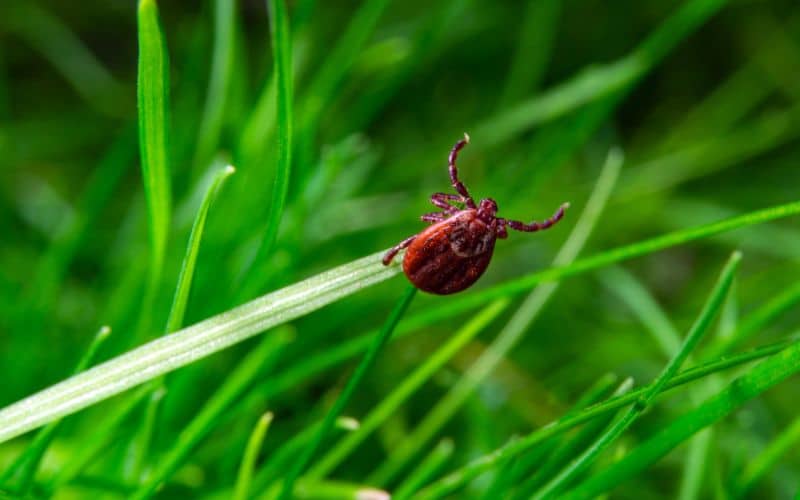
The Tick Dilemma in Your Lawn
The great outdoors! There’s nothing like feeling the grass under your feet and the sun on your face. But wait, what’s that crawling on your leg? A tick! Yes, these tiny pests are not just a wilderness issue; they can make themselves at home right in your lawn. And let’s not forget, ticks are notorious for spreading Lyme disease. So, let’s get down to the nitty-gritty: how do you deal with ticks in your grass?
Do Ticks Live in Mowed Grass? The Surprising Answer
If you’ve been under the impression that a freshly mowed lawn is your ticket to a tick-free paradise, prepare for a plot twist. Contrary to popular belief, ticks aren’t picky about the height of your grass. Whether it’s a jungle out there or a well-manicured carpet of green, ticks can and do make themselves at home. Cutting-edge research reveals that the act of mowing alone isn’t enough to send these pests packing. So, before you rev up that lawnmower thinking it’s your weapon against ticks, it’s time to reevaluate your strategy.
What Makes Your Lawn a Tick Habitat?
Ticks are opportunistic creatures, always on the lookout for their next meal. Your lawn can become a tick haven for several reasons. First, tall grass and weeds provide the perfect cover for ticks to hide and wait for a host. But it’s not just the vegetation; the microclimate matters too. Ticks thrive in humid conditions, and a lawn that’s not well-maintained can offer pockets of moisture, especially in shaded areas. Add to that the presence of leaf litter or even small puddles, and you’ve rolled out the welcome mat for ticks. If you have pets that frequent the yard, their movement through the grass can also attract ticks, making your lawn a bustling tick metropolis.

How Do Ticks Typically Behave in Grass?
Ticks are masters of patience. They can’t fly or jump, so they rely on a fascinating behavior known as “questing” to find their hosts. Here’s how it works: a tick will climb to the top of a blade of grass or a weed and extend its front legs, which are equipped with sensory organs. These organs can detect changes in temperature, humidity, and even the carbon dioxide produced by potential hosts. When you, your kids, or your pets walk by, the tick senses the movement and latches on. From there, it seeks a suitable spot to bite and feed. This is why it’s crucial to check yourself and your pets for ticks after spending time in grassy areas, especially if you’ve been walking through tall grass where ticks love to quest..
Is Mowing the Lawn an Effective Tick Control Method?
While mowing your lawn might seem like a simple and effective way to keep ticks at bay, the reality is a bit more complex. Sure, cutting the grass short reduces the vertical space where ticks can quest, but it’s not a silver bullet. Ticks are resilient and adaptable; they can still find places to hide even in a well-mowed lawn. For instance, they might take refuge in leaf litter, garden beds, or even your outdoor furniture. Additionally, the effectiveness of mowing as a tick control method can be compromised by other factors like humidity and shade. If your lawn has areas that are consistently damp or shaded, mowing won’t deter ticks from setting up shop there. So while mowing is a step in the right direction, it should be part of a broader tick control strategy that includes other measures like repellents and yard maintenance.
Tick Repellent: What Works and What Doesn’t
Navigating the world of tick repellents can feel like a maze. There’s a plethora of options, each promising to be the ultimate solution to your tick woes. But not all repellents are created equal. Some are specifically formulated to target ticks, while others are more general insect repellents that may not be as effective against ticks as they are against, say, mosquitoes. When choosing a tick repellent, look for products that contain active ingredients like permethrin, DEET, or picaridin, which have been proven to be effective against ticks. It’s also important to consider the application method. Sprays are easy to apply but may require frequent reapplication, while granular forms can offer longer-lasting protection but may be less suitable for areas where kids or pets play. Always read the label and follow the manufacturer’s instructions to ensure you’re getting the maximum protection without compromising safety.

How to Keep Ticks at Bay: Best Practices
When it comes to tick control, your lawn is just the tip of the iceberg. A comprehensive approach is key to making your outdoor spaces less appealing to these pesky parasites. First off, don’t overlook your outdoor gear and clothing. Treating them with a tick-specific repellent can add an extra layer of protection. As for your yard, regular maintenance is crucial. Keep the grass neatly mowed, pull out weeds, and clear away leaf litter and debris. These actions eliminate some of the tick-friendly microclimates in your yard. If you have a compost pile, make sure it’s well away from areas where people and pets frequent. And don’t forget to check and clean places where ticks could hide, like garden ornaments, under decks, or even in the folds of outdoor furniture cushions.
Shrub Management: An Overlooked Factor in Tick Control
While much of the focus on tick control centers around lawns, shrubs are often the unsung villains in the tick drama. These leafy plants provide an ideal environment for ticks to quest and latch onto passing hosts. Pruning your shrubs, particularly the lower branches, can significantly reduce the tick-friendly zones in your yard. When you cut back the foliage, you’re not just improving the aesthetics of your garden; you’re also disrupting the tick’s natural habitat. This is especially important for shrubs that are close to walking paths or areas where pets and children play. Consider replacing dense, low-lying shrubs with taller, more open varieties that are less inviting to ticks.
Can You Really Get Rid of Ticks Completely?
While it’s tempting to dream of a completely tick-free yard, the reality is that ticks are tenacious little critters. They’re survivors, and completely eradicating them from your outdoor spaces is a tall order. That said, you can make a significant dent in their population and, more importantly, reduce the risk of tick-borne illnesses like Lyme disease. Consistent and comprehensive tick control measures can make your yard far less hospitable to ticks. This includes everything from regular lawn maintenance and targeted repellents to managing shrubs and other potential tick habitats. It’s also crucial to be vigilant about checking for ticks on yourself, your kids, and your pets after spending time outdoors.
Seasonal Tick Control: When Is the Best Time to Act?
Ticks don’t take a vacation; they have peak seasons when they’re more active and more likely to come into contact with humans and pets. Late spring through early fall is prime tick time, thanks to the warmer temperatures and increased humidity. This is when you should be most vigilant and ramp up your tick control efforts. During these months, consider applying a tick-specific repellent to your lawn and garden. Some repellents are designed to be effective for several weeks, providing ongoing protection during the tick season. It’s also a good idea to treat outdoor gear and even the family pet with tick repellent. Remember, ticks can hitch a ride indoors on clothing and pets, so seasonal vigilance is key to keeping them at bay.
Conclusion: Your Action Plan for a Tick-Free Lawn
Ticks are a year-round problem, but with the right strategies, you can make your lawn a less inviting place for these pests. Mowing the lawn, using tick repellent, and keeping your yard clean are all steps in the right direction. Remember, ticks don’t just live outdoors; they can make their way indoors too. So, take action today for a tick-free tomorrow.








